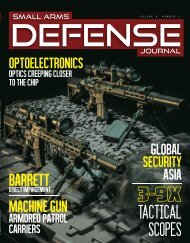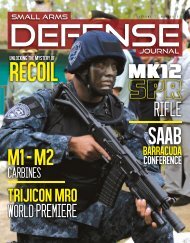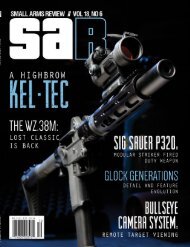Create successful ePaper yourself
Turn your PDF publications into a flip-book with our unique Google optimized e-Paper software.
Secret<br />
proclaimed short-recoil operation inherently<br />
less reliable than gas operation. The<br />
government was advised all future development<br />
should be of gas powered weapons.<br />
The decision to begin full production<br />
of the unproven Dror was roasted as irresponsible.<br />
Of course, with names like David<br />
Ben Gurion and Haim Slavin behind<br />
the project, it is hard to imagine how anyone<br />
could have stopped it.<br />
In the U.S., Johnson continued development<br />
of his rifle and LMG after the<br />
war, melding them into sleek and evolved<br />
models that unfortunately met little commercial<br />
success. There is no indication<br />
Johnson knew about the Dror. Johnson<br />
Automatics filed for bankruptcy in 1949.<br />
The auction of equipment took place in<br />
March the same year. Some machinery<br />
and tooling may have made its way to Israel<br />
to supplement the Toronto contribution.<br />
Johnson moved on to development work<br />
on several other military projects.<br />
The Johnson guns might have been<br />
still-born were it not for Holland’s all-important<br />
order. A generation later, a Dutch<br />
firm would produce the AR-10, which used<br />
the multi-lug locking system from the<br />
Johnson. Johnson himself helped develop<br />
the AR-10. Without the AR-10, the AR-15,<br />
the M16, and the M4 family still in use,<br />
would not have evolved. Considering this,<br />
Holland and Johnson had a remarkable influence<br />
on American weapons.<br />
The existence of the Dror was a secret<br />
until well into the 1950s, and by then, a<br />
mild embarrassment. By the time the Dror<br />
became public, the lawyers were baffled. If<br />
the ownership of the patents was not muddied<br />
by bankruptcy, there was the question<br />
of who to sue: Israel didn’t exist when<br />
the Dror was hatched. Considering the<br />
failure of the gun and the fact production<br />
was cancelled, it isn’t surprising no legal<br />
action is recorded.<br />
EPILOGUE<br />
In 1950, the Dutch Johnsons were deployed<br />
in the Philippines against the Hukbalahap<br />
Rebellion and by the Philippine<br />
Expeditionary Forces to Korea.<br />
Hilda Ekdahl caught tuberculosis<br />
tending a sick relative and died tragically<br />
in 1949. Sadly missing her, Carl Ekdahl followed<br />
in 1952; but, according to his daughter,<br />
C. Elise, he died a man ‘happy with his<br />
legacy.’ A hundred years after he arrived in<br />
America, Carl’s descendants span America<br />
from coast to coast and north to south. He<br />
is remembered in Israel.<br />
Melvin Johnson Jr. died in 1965, still<br />
working, of a heart attack. His memory<br />
and achievements are preserved by the<br />
Johnson family and known to millions.<br />
Norman Grant, credited with running<br />
the Toronto operation, moved easily into<br />
manufacturing lighting.<br />
Haim Slavin retired from Ta’as and<br />
kept on engineering. He developed some<br />
of the pre-fab concrete housing techniques<br />
seen throughout Israel today.<br />
Yisrael Galili became known as the<br />
‘Father of the Rifle’ in reference to the Galil<br />
rifle designed by himself and Yaacov Lior.<br />
He died in 1995.<br />
Max Brown went to Palestine to serve<br />
in the War of Independence. He worked<br />
for Ta’as, likely with Ekdahl, then returned<br />
to Toronto and founded a chain of appliance<br />
stores. He passed away in 2013 in Miami.<br />
He is buried in Israel.<br />
Between 1965 and 1969, Leonard<br />
Slater researched and wrote The Pledge<br />
recording the details about the development<br />
of the Dror and the broader effort<br />
to arm Israel prior to the 1948 war. Slater<br />
worked with NBC, Time and Newsweek, to<br />
name just a few. He died at 84 in 2005 at<br />
his home in Mission Hills, California.<br />
Bruce N. Canfield, with Robert L.<br />
Lamoreaux and Edward R. Johnson, published<br />
Johnson’s Rifles and Machine Guns<br />
through Andrew Mowbray Publishers in<br />
2002, illuminating the long untold Johnson<br />
story. Canfield, a premier authority on<br />
American small arms, continues to write.<br />
However the story ended, the Dror is<br />
an incredible achievement by a small dedicated<br />
band led by Haim Slavin and Carl<br />
Ekdahl. Drors still exist in museums and<br />
the hands of collectors in Canada where<br />
the few released were sold as ‘Converted<br />
Automatics’ in the mid-1980s. Others were<br />
broken down for parts.<br />
As a footnote, I dropped the butt<br />
of my .303 version on my foot, painfully<br />
blackening a toenail. In recorded history,<br />
this may have been the most significant<br />
wound inflicted by the Dror.<br />
(Acknowledgement and thanks are<br />
due to Leonard Slater, author of The<br />
Pledge, Larry Collins and Dominque Lapierre,<br />
authors of O Jerusalem and to Bruce<br />
N. Canfield, author of Johnson’s Rifles<br />
and Machine Guns with Robert L. Lamoreaux<br />
and Edward R. Johnson, (Andrew<br />
Mowbray Publishers). A special thanks to<br />
Carl Ekdahl’s descendants, John Ekdahl,<br />
David Nordin and Kirsten O’Brien for<br />
their guidance, information and photos of<br />
their Grandfather, to Richard Collins for<br />
providing the 2nd model Dror, Charles<br />
Taylor of Movie Armaments Group in<br />
Toronto, Canada for use of the facilities,<br />
Graham Robertson for his photo, and G.<br />
N. Dentay, Paul Wassill and R Blake Stevens,<br />
Collector Grade Publications, for<br />
their invaluable editorial input.)<br />
64 SADEFENSEJOURNAL.COM









